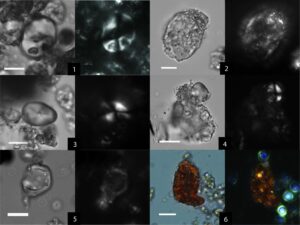Beer drinking is not a practice only in the modern era. In fact, grain was turned into the bubbly yellow liquid millennia ago. One can imagine how residents in the emerging society 7,200 years ago at Tel Tsaf – an archaeological site located in the central Jordan Valley southeast of Beit She’an – sat around drinking beer not only as a ritual or ceremonial practice for also for socializing.
It was first dug in 1978 to 1980 by Tel Aviv University archaeologists and in 2004 to 2007 by Hebrew University of Jerusalem colleagues. In 2013, the University of Haifa and the Zinman Institute of Archaeology renewed excavation of Tel Tsaf, which is dated to 5,200 to 4,700 BCE, sometimes called the Middle Chalcolithic period in the Levant. Common finds included numerous flints, pottery and animal bones.
Prof. Danny Rosenberg of the Zinman Institute, who led the research together with researchers from Stanford University in California and the German Institute in Berlin, have unearthed the first evidence in the ancient East of beer consumption at the site. The ancient residents were “wealthy,” as there is evidence of accumulated agricultural produce and especially large-scale grains for the production and consumption of alcohol.
The earliest evidence of beer consumption was found at the Natufian burial site in the Cyclamen Cave in Carmel, from about 14,000 years ago. In a study published in 2014, researchers from the University of Haifa found evidence of beer consumption – alcohol fermented from grains – in the context of burial rites. According to Rosenberg, who was also involved in that study, since that discovery of beer consumption in the Natufan period, the evidence for beer consumption in the Levant is very fragmentary and almost non-existent (but it became very common in Egypt and Mesopotamia a few hundred years later).

The Chalcolithic site at Tel Tsaf was a very large settlement and inhabited by hundreds of people. The uniqueness of Tel Tsaf is that it is one of the few localities in our area from this period of transition from agricultural groups who inhabited villages that were usually not large and between societies that became urban.
The researchers found evidence that the settlement flourished exceptionally for several centuries during which its inhabitants accumulated agricultural produce of exceptional proportions and even forged extensive trade ties with areas many hundreds of miles away, with sites in Egypt, Jordan, Syria and Iraq and even Anatolia and beyond.
In the present study, the researchers examined a microscopic study of wheat and barley starch grains found in various pottery vessels in Tel Tsaf, including filters, and found that the grains underwent a molecular change in the fermentation process that indicates that they actually underwent a process of fermenting and producing ancient beer.
According to the researchers, the evidence for the existence of a stable social and economic system in Tel Tsaf is well connected with the evidence for alcohol production. “The existence of such a system often depended on “routine maintenance,” which has often included increased alcohol consumption, the researchers said
The production and consumption of beer apparently did not cease after the Natufian period in which hunter-gatherers lived who began to sit permanently and engage in primary agriculture. This practice did not emerge in the Bronze Age, the archaeology team said.
There were excellent preservation conditions in Tel Tsaf that allowed various organic materials to be exceptionally preserved. “It is difficult to know whether the beer whose production process we identified at the site was consumed daily or at large social events in which all or most members of the community participated, but the accumulation of evidence from excavations at the site indicates extraordinary wealth and prosperity,” said Rosenberg. “We hope that in the near future, when we can isolate more evidence of beer production at the site and at others, we will be able to get a closer look at the role of alcohol in ancient societies and especially those, such as the community living in Tel Tsaf, who underwent fundamental changes.”
The shortcode is missing a valid Donation Form ID attribute.




